The Preacher Friar's Way (16th Century)
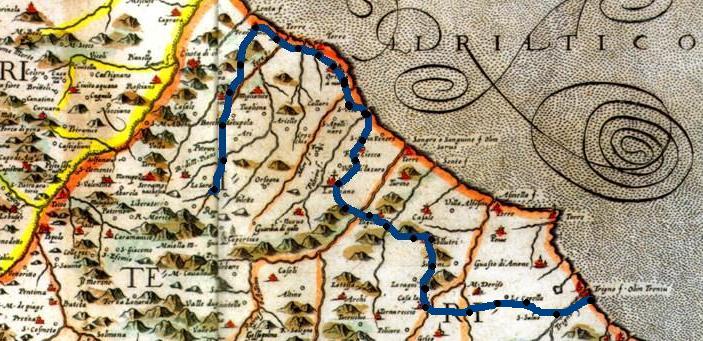
The Dominican monk Serafino Razzi on the orders of his superiors, set off from Perugia on the 12th July 1574 for the “Abruzzi” as they were known at the time, where he travelled far and wide, praying and walking around the countryside of the region, for a good three years. In his unrelenting but tiring journey on foot he took note and described in minute detail everything he met on his walk, customs, traditions, local sayings, works of art, antique inscriptions, cities, villages and even the most secluded paths, privileged to have the benefit of his prayers, even in the smallest of villages. He was meticulous in his descriptions of every stop on his itineraries of Abruzzo, leaving images of a time gone by, precise and authentic like no other documentation of the area. |
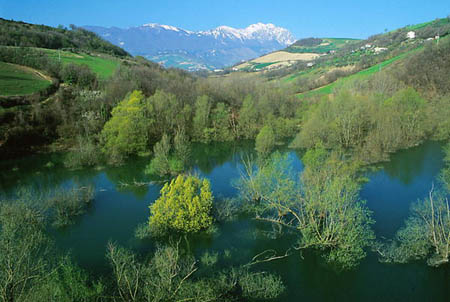
Penne, natural reserve | The monk spent time in Penne a small town in the province of Pescara, one of the highest points, where one can experience the elevated landscapes and views which even today dominate the valleys situated below, between the rivers Fino and Tavo. It is here in this charming town that we can meet to follow in his footsteps, visiting the villages and hamlets along the way. With a guided tour of the Nature Reserve of the Lake of Penna, we can begin our journey following in the footsteps of the Dominican monk. From these places Father Serafino, with a careful eye made is untiring 15th century walk, taking his evangelical works along the wild paths of Abruzzo, and the results of these wanderings can be found in manuscripts in the National library of Florence and in other places along the Adriatic. |
In this proposed itinerary, we will walk with him along the fascinating paths of the Teatina coast. Places where culture, ambience and traditions deepen, offering the traveller the possibility of exploiting places and their history. The modern visitor can rediscover the charm of the old country paths by accompanying the monk on his visits to the smallest of villages, or the bigger cities, identifying the short cuts, unchanged with time, are the natural landmarks which have remained intact, preserving their primordial beauty, running down the notes made by the monk and moving along the unforgettable routes, one is exposed to the remote and timeless wonders which are able to touch our consciences. |
The detail, the care and the attention paid to every particular of the life of both the places and people that Razzi met during his walk, allowed this remote figure, access to the archaic rituals, ways and customs, and this gives us a clue to the type of life led by people of the time through today’s eyes as Adriatic travellers. We are able to experience traces of habits, long forgotten crafts, lively centres, deep spirituality, monuments and ancient house, accompanying Father Serafino will introduce us to these roads where we will be able to continually con front the past with the present through the eyes of a Viaggiadr traveller.
Leaving from Civita di Penna, we move towards the teatine province.
| 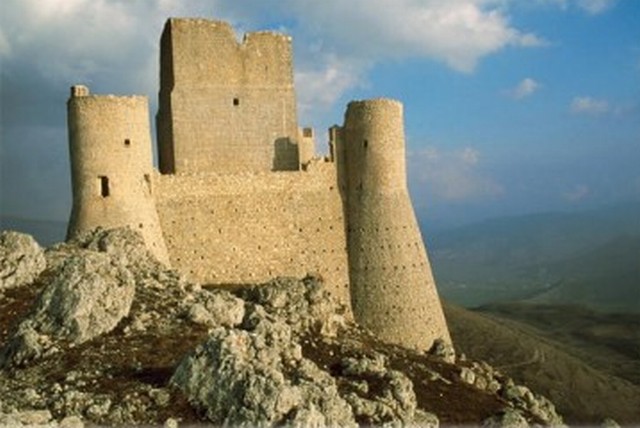
Penne |
On the 6th June 1575 the monk along with a companion, angrily left for the Fair of Lanciano and at the fourth mile at Colle Corvino, he celebrated the holy mass.
We advise our travellers also to take a brief rest, a moment to take in the old view of the Mediaeval castrum and enjoy the charming views, Collecorvino rises, in fact from a hill which is part of the Valley of the Tavo, and is at 253 metres above sea level, with a panorama which embraces both the mountains and the sea, short cuts that reveal woods and a country stopping places , and between one walk and another one can enjoy a delicious slice of bread with oil, and deepen ones knowledge with a bit of history. In this land the monk stopped just long enough to say vespers before immediately moving on towards the coast: We now continue our travels and after 11 miles of the River Tavo, we leave Mount Silvano on our left and on the right Spulture…
|
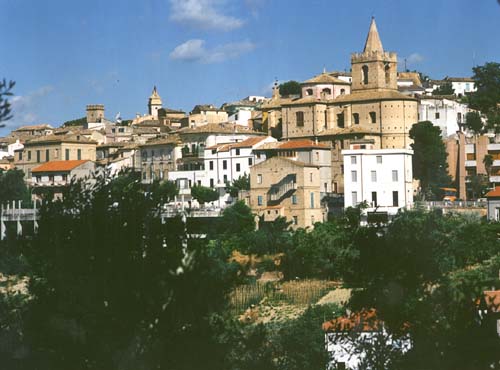
Spoltore | 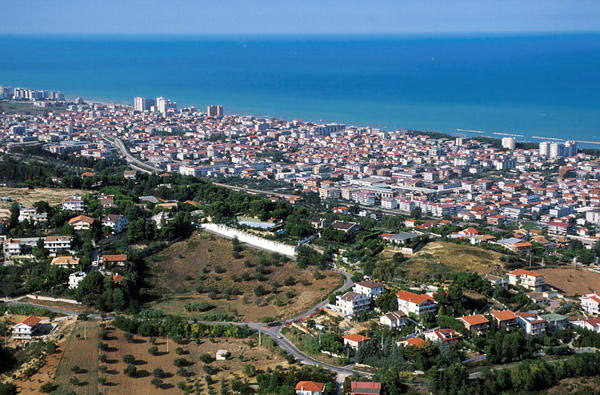
Montesilvano |
The two centres make up part of the hinterland of Pescara, hiding pleasant surprises for the more attentive traveller, who can witness the transformation of Montesilvano from old times to the modern day. “Castellum Montis Silvani” had already been mentioned as early as 1195, tradition saying that the original hamlet has traces dating back to the 14th century, and was founded by the superstitions of the old Angulum, now known as Città S. Angelo, after being destroyed on the orders of Frederick II. Now we can start our journey again with our monk who is due to learn about Pescara: |
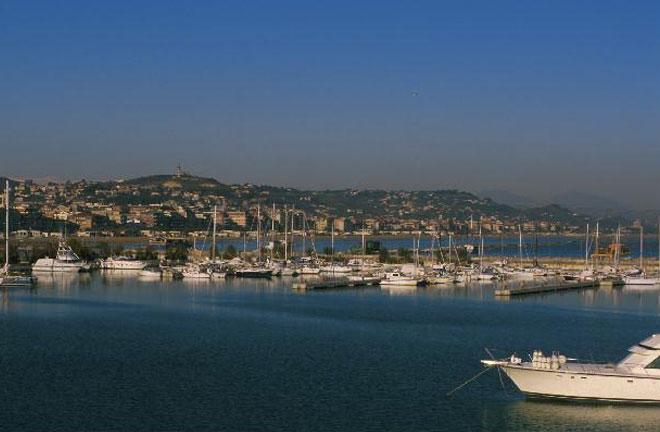
Pescara |
before taking the road out of the Cantalupo Valley, we will take another which will take us high above the river Tavo, where we will find ourselves in front of the city of Pescara, which illustrates the nobility of the Grand Marquis, where one can see this nobleman’s remains.
From here, together with our monk we can start our walk again this time along the Marina; Certainly refreshed by Pescara, we will another five miles after the Marina, a fresh and delightful journey; until we reach Francavilla, place on the found on the shores of the sea, noted for its beautiful view. |
One of the oldest nuclei and built with old mediaeval towers and walls, on an enchanting hill in which one can enjoy its beautiful panoramas overlooking the sea. One can visit the church of San Franco, with a sacred shining silver ostensory, made by Nicola da Guardiagrele in 1453. | 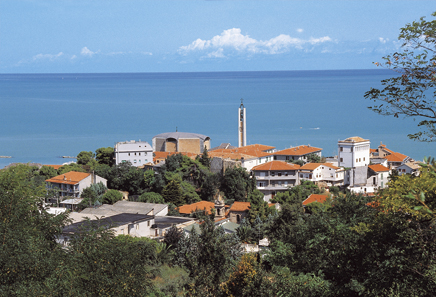
Francavilla |
The city is one of main centres in the area and is where it is possible to visit architectural and historical sites.
Thursday 9th June after vespers, leaving Lanciano, we went for about 4 miles until we reached Santo Vito, port and known as the city of the marina.
So in effect, placed against a ridge, jutting out towards the sea, San Vito stands never endingly in the crystal clear Adriatic waters, that even from the oldest of times presenting itself as an ideal place for the building of a port. |
The "fresh and delightful journey" made by the monk along this coast, which one can still today and follow with intense emotion (particularly if you decide to travel in period between September and June) through one of the most enchanting and charming coast lines, still with relevant and interesting attractions. From Ortona until you reach Vasto, in fact, the coast is not only characterised by its long golden beaches, but also by ravines, peaked cliffs which jut out into the Adriatic, hidden beaches away from and impervious to mass tourism, with its rocky paths and more importantly with its atavism for fishing especially by the population. | 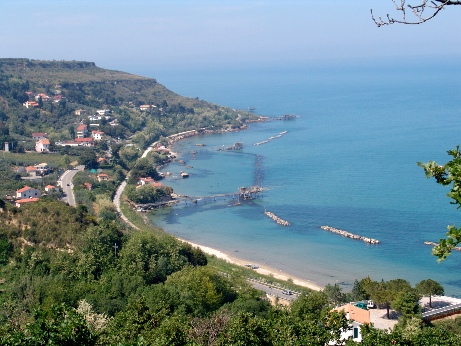
San Vito |
This place takes its name Costa dei Trabocchi from the fishing tackle used on this marvellous stretch of Abruzzian coast. As one goes from Ortona to San Salvo, San Vito Chietino, Rocca San Giovanni, Fossacesia, Sagro and Vasto, one can see this particular type of fishing extended along the coast line.
The inebriant pulling of the nets, when the silver, darting of the fish is confounded by the blinding flashes of the sea, which offers a different type of tourism, new and able to move slowly in order to taste the flavours, and the to soak up the history of the places allowing the spirit of the place to penetrate the soul.
|
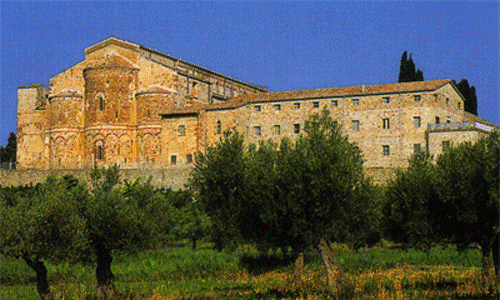
Fossacesia, Abbey | 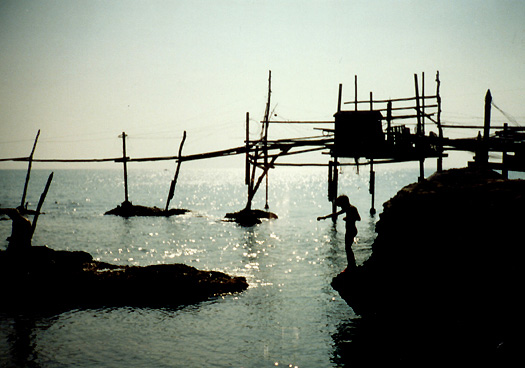
Rocca S.Giovanni, Trabocchi |
Cultural fairs, and gastronomical events are invariably organised, other than in the summer months, so that one can take advantage of the charming atmosphere of the “trabocco”, where the past and present are perfectly integrated, immersed in the unspoilt greenery that has stimulated the artistic and intellectual juices, including those of Cascella and D’Annunzio, “a strange fishing machine, made up of tables and beams, rather like a gigantic spiders [...] stretching out over the cliffs, like an ambushed monster, with its hundred arts, the “trabocco” had a formidable aspect. […] the fishermen appeared bent towards the waters, fixed immobile like bronze statues. This weighed upon their tragic lives mortally enchanted.” (G. D’Annunzio, Triumph of Death). |
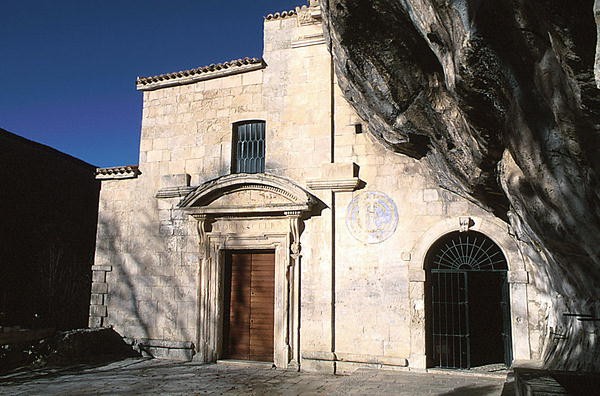
The Eremo of S.Vito |
Nevertheless, it was D’Annunzio who was extremely attached to these places. “l’animus del Vate” wafts along all the coastline of Abbruzzo, with its verses , which almost seem to float amongst the leaves , and in the foaming sea, in the chirping of the birds, in the branches of the elms, olive trees and where it is possible to visit the country house where the poet stayed. It is called Eremo dannunziano, and be found in one of the most fascinating places on the “ Costa dei Trabocchi”, Punta Turchino. But for now we will continue our walk in the footsteps of Father Razzi, away from the old sea port going northwards, inviting you to visit yet another characteristic city: (and therefore) passing the River Morrone at its outlet, where there were many boats trying to reach Ortona before night fall, city situated overlooking the sea,, on a hill, very elusive and beautiful, with a fort and a port, and characterised by a convent of our order. |
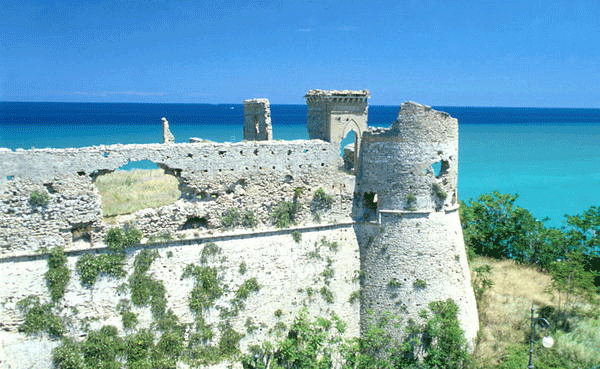
The castle of Ortona | It was the same Razzi who informs us of the miraculous event that leads to the relics of the saint of Ortona, which today is recaptured every year in the celebrations of the patron saint. If only by the “splendour and the celestial candle light” of the saint which still remains “above the port” today we can enjoy a relaxing walk along the splendid “Passeggiata Orientale” from where one can see the spectacular view of the gulf which stretches out as far as “Punta della Penna”, going down towards the marina where one can experience even today, as once experienced by Father Razzi, the pulling in of the “sciabica”, old fishermen’s’ technique. One cannot exclude the possibility of being given a freshly fished fish as was our monk 400 years previously, |
After Vespro, leaving from Ortona, for earth, we travelled a further eight miles, until we reached Lanciano,and not having a place to lodge in our convent we stayed the night with Rev.p. Zoccolanti, where we were lovingly looked after. where he said the Mass, went down to the port, situated under the convent and was given a catch of fresh sardines. From Ortona the monk returned to Penne, from where he left several months later for Vasto. The Itinerary proposed takes you along the “Costa dei Trabocchi”; otherwise, as done by Father Serafino, one can opt for the internal roads which can be covered even today by car, but at the same time offer a sense of following the old route. |
So in the same way as our old traveller we can stay in a remote but renovated, functional but welcoming , oozing with atmosphere of archaic hospitality, an old convent or in another more secular way, or be enchanted by the sumptuous attractions provided by an old “masseria”. On the 21st May, rising at an early hour, having said Mass we left Lanciano, and passed a further six miles along the river Sangro, crossing over the wooden bridge, made specifically for the passing of livestock through the customs, returning back to Puglia, a little behind, we left Paglieto, a small walled castle, property of the Palma family, moreover the landlords of Villamagna, waves above the port, and their emblem below, a palm, an elusive tree, with the following latin inscription “Palma manus: Arbor palma: Victoria palma”. | 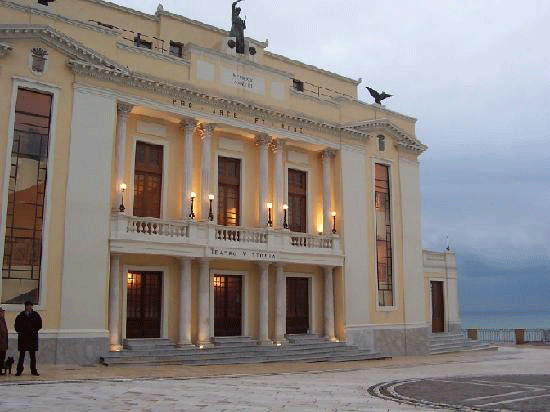
Victoria Theatre, Ortona |
With a little burning of the sea the vegetation is transformed, above all in the autumn, were we can enjoy the marvellous colours of the grape harvest. Walking a little way inland we can catch sight of Atessa, built above an elusive hill, with its beautiful and fertile contours and greatly inversed Adriatic marina, that once seen is a real pleasure […] of which has 4 parishes, and three convents, those being of the Celestines, of the Zoccolanti Fathers, and ours. From here is the road that leads down to Vasto and the beautiful church of San Rocco. |
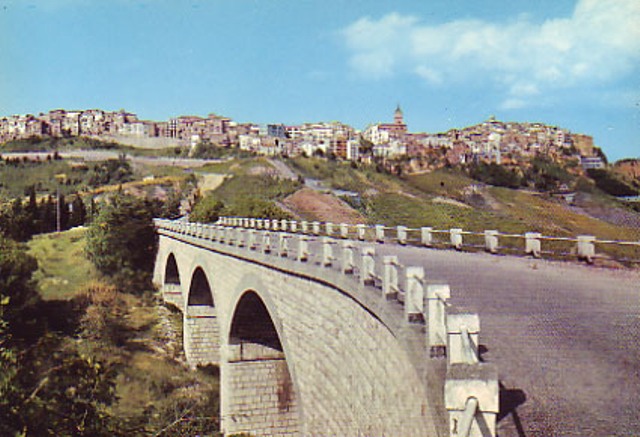
Atessa | 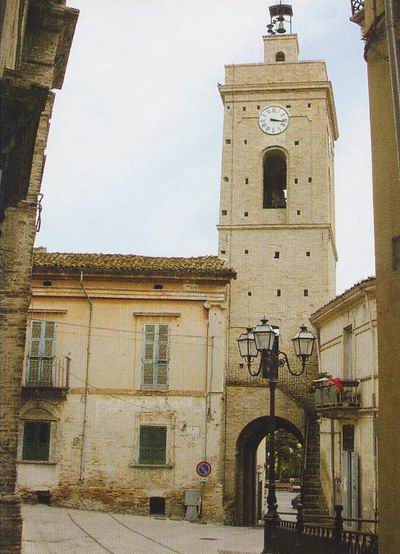
Paglieta |
One can take advantage in these places of the excellent wine and food produced, in fact we would like to advise you stop for lunch in one of the many farmhouses, where you can sample, among other things, an excellent “ventricina”, going on a little further there is Guilmi or the enchanting hamlet of Gissi, a renovated fortified nucleus which was recorded as early as 1095 in the Catalogus Baronum. One finds oneself a little off the track of our monk, but one is only a few kilometres from the other, and well worth a visit. In fact if you want to spend a different kind of day we advise you to go up into the fields and taste their delightful perfumes and smells, different in every season. The marvels of the fields also accompanied our monk on his travels. |
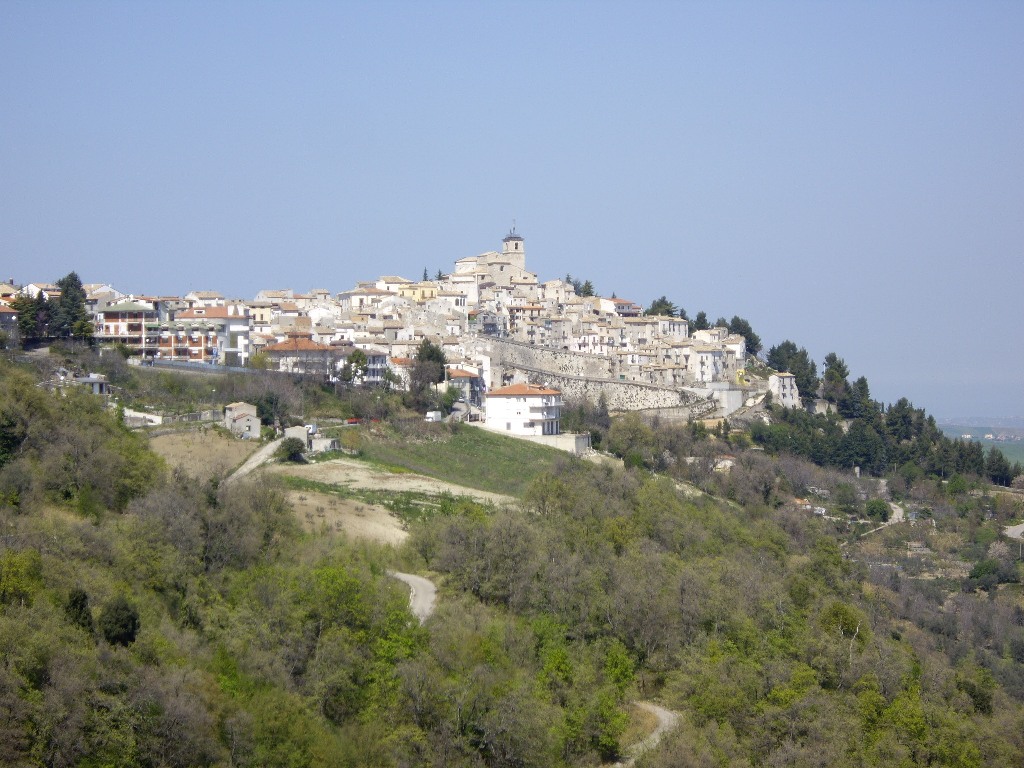
Gissi | 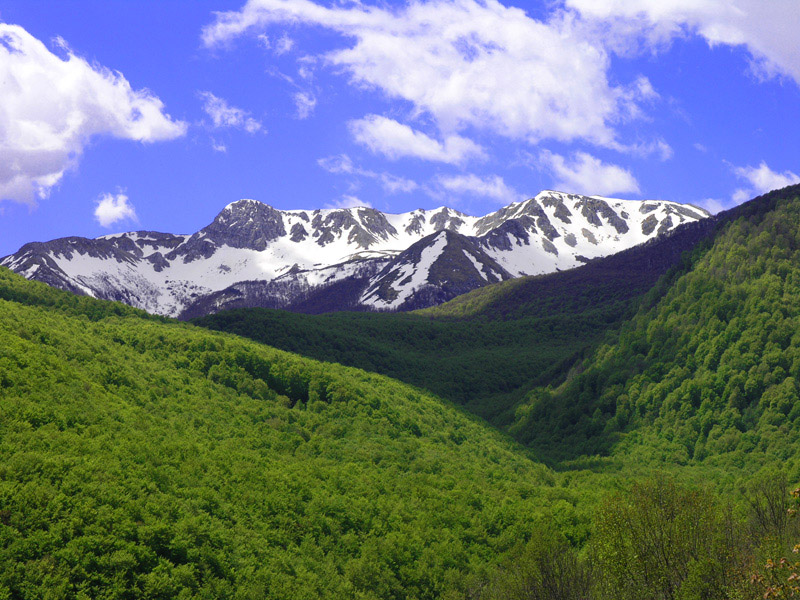
Guilmi |
So walking onwards, along the land between the sea we found Casale bordino, a village of Vasto. |
For Father Razzi this land of luscious vegetation (Castel Verdino, as it wanted to be known and not Bordino, as it was vulgarly was. Verdino is noted for its perpetual greenery[...]) had notable fascination.
This land was greatly civil, far from Vasto, and towards Lanciano, seven miles away, of a 140 fires, walled, with a healthy air, perfect wines, and abundance of water, and close to the River Asinello. | 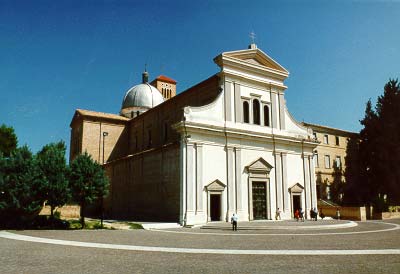
Casalbordino, Sanctuary |
But my journey continues: |
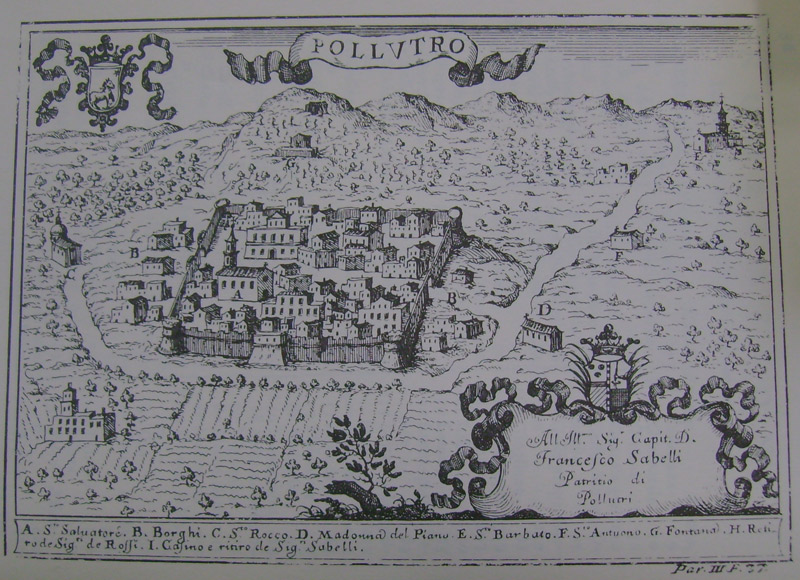
Map of the city of Pollutri |
And after being once more refreshed we once again begin our walk(…) leaving on our right Pollutre and the castle of Montedorice (…) noble lands (…) about three miles from Vasto and given the title County, which is mentioned by Monsignor Giovio, in his stories, the very same Monte Doris. |
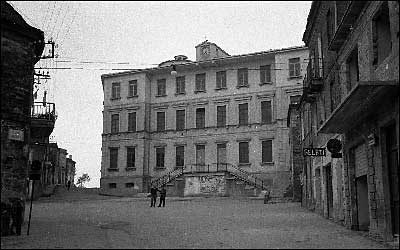
Monteodorisio, Piazza Umberto I | Other than the pleasures of good food, these places offer the possibility of a total immersion in old history. Recent archaeological finds support the theory of the existence in Pollutri of a pre Roman aged settlement. |
After eating and drinking a good meal, perhaps some excellent “ventricina” or some roast pork in one of the numerous masserie (old fortified farmhouses), for example in or around Scerni, followed by a relaxing work in the Bosco di Don Vernanzio (small wooded area),a place of particular interest in the area of Pollutri. We can continue our journey in the footsteps of our old monk, following the green footpaths and hills until we reach the river Asinello, where we will finally reach Vasto, 18 miles from Lanciano. |
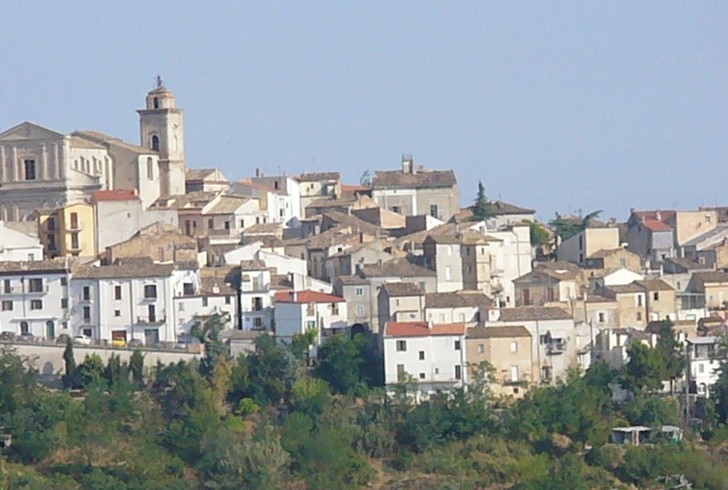
Scerni |
Vasto, a delicious land, already known by many as a little Naples, situated in low lying land, surrounded by mountains, but still above sea level, which can be found about half a mile away. This place abounds itself with all that is good, bread, meat, fish and eggs. And its wines that every year are greatly valued and are loaded on to ships and sent to such places as Ischiavonia and Venezia and many other places. Not only are the wines good but are of good value too. |
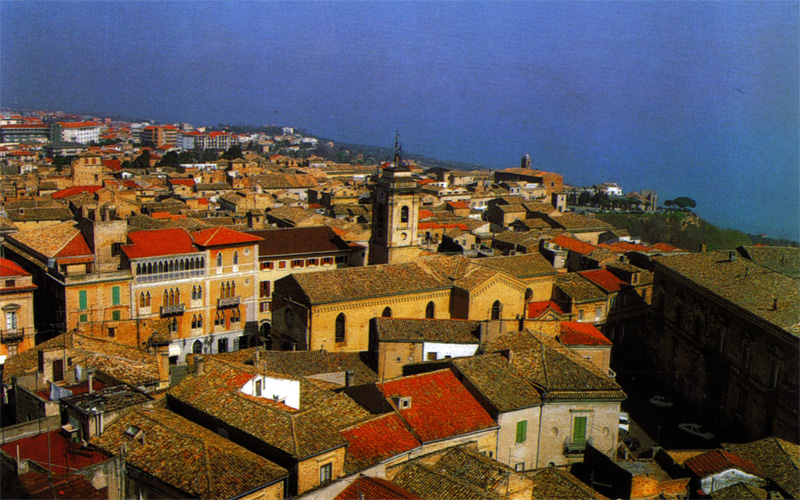
Vasto | Wheat, however, even though the land is good, is not much harvested. The land is nonetheless abundant in oil, oranges, and is surrounded by woods, largely towards the sea, it’s a place where one can always eat and drink well. |
Our convent which is called “la Nunziata” has only one cloister but with an excellent cistern. It has a dormitory with ten cells, with a good loggia, and a good view of the sea. It does not have a small vegetable garden, a refectory, a kitchen, but not a capitulary, or a hospice, an infirmary, nor a school and it be difficult to have a workshop, due to the position of the place, a walled building on the edge of the sea. | 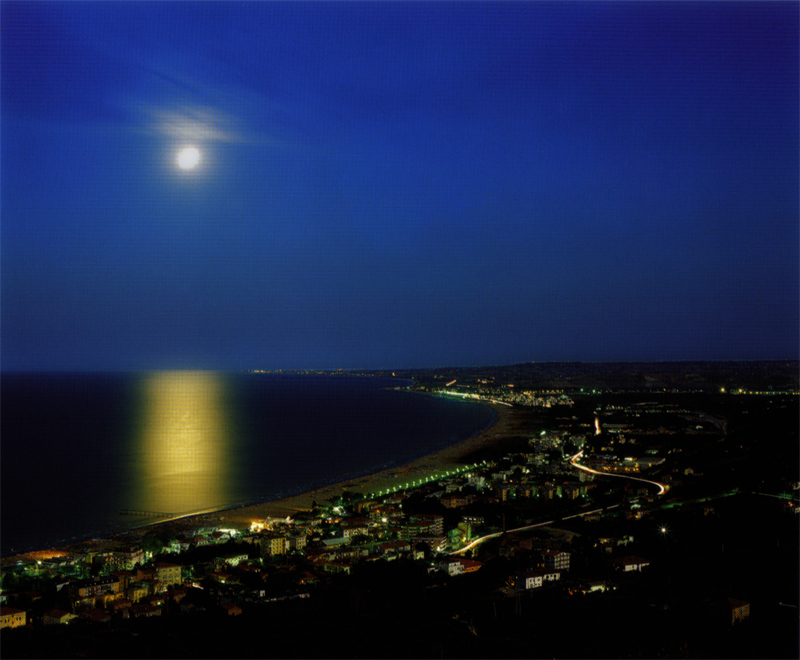
Vasto, night-panorama |
On the opposite side of this old neighbourhood, there are some enchanting walks going in a westerly direction, where we can discover that the area was victim to in 1956, a terrible landslide which caused the disappearance of the whole area and the Cathedral of San Pietro, where our monk Serafino said his first prayers to the city. | 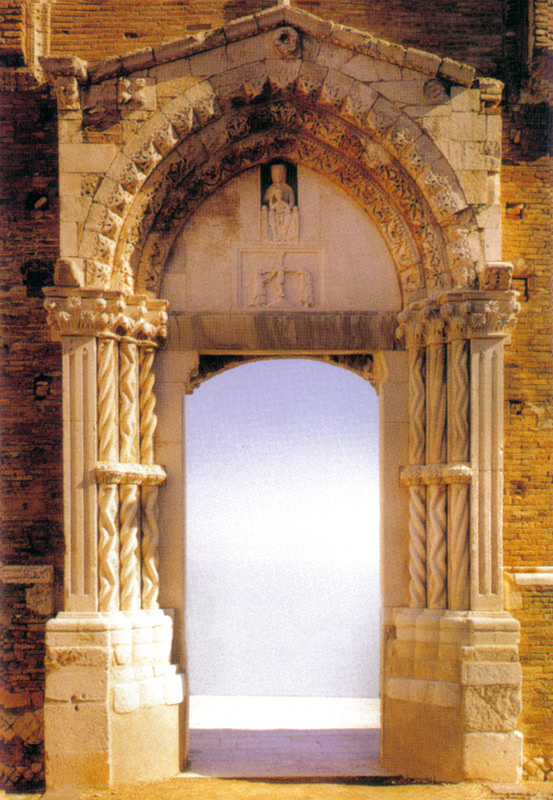
Portal of the church of S.Pietro | On 27th May, which was the fourth Sunday after Easter, I said my first prayers in the church of San Pietro, one of the two parishes found in this land. |
Only the portal remains of this old church, with its distinguished window overlooking the charm of the Adriatic. |
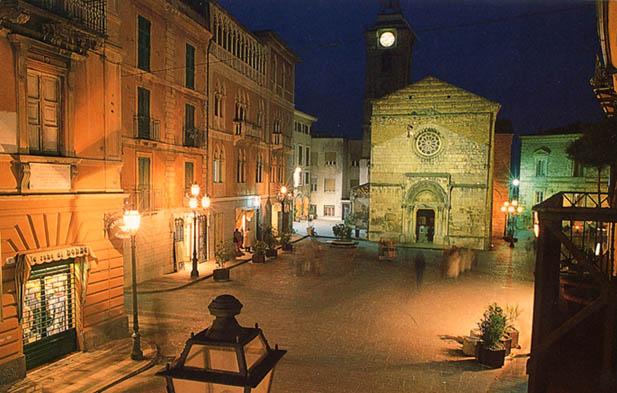
Vasto, Corso De Parma and the cathedral of S.Giuseppe | For the modern traveller retracing these paths, between the hills and the sea, its still rich in olive trees, oranges and juniper even today, it is easy to recapture the atmosphere, it has the same smells and it is easily able to evoke the old memories. Today, the modern traveller can choose which way to travel, along easier paths, on foot, or by car, or be adventurous by taking the pleasant paths, and reliving the spiritual and religious experiences. |
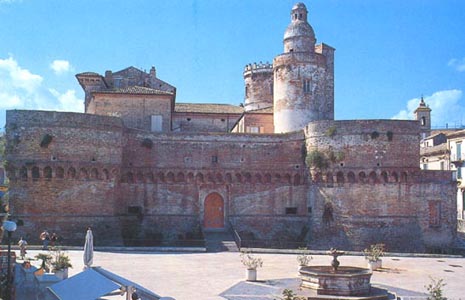
Castello Caldoresco | Set in the natural scenery of the coast, the sheer drops over the sea, the city leaves you to guess the signs left by history, especially when you move around the historical centre, which overlooks the sea and which offers views of steep cliffs and pounding waves. One can look for the remains of by gone days, or visit the majestic 14th century castle which takes its name from the builder Giacomo Caldora, Castello Caldoresco, or reach the beautiful Marquis palace, an architectural jewel of Vasto. | But still following the path of 15th century monk, on his untiring journey, we can find in the surrounding area places such as Cupello, for example, an old Schiavoni village, which still preserves its great understanding of its origins, which at the time of the monk was recently founded. | 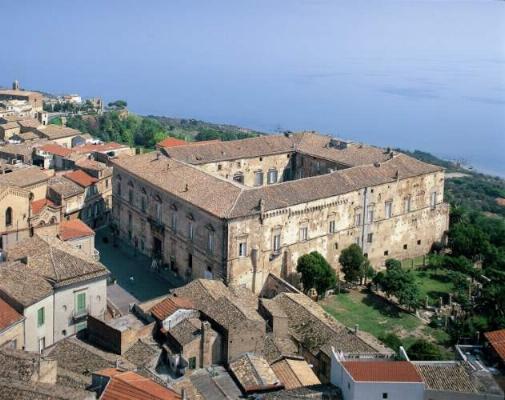
Palazzo D'Avalos |
He takes time to describe the clothes, and customs of these new people, taking in to account their language, if not we can go towards Lentella, |
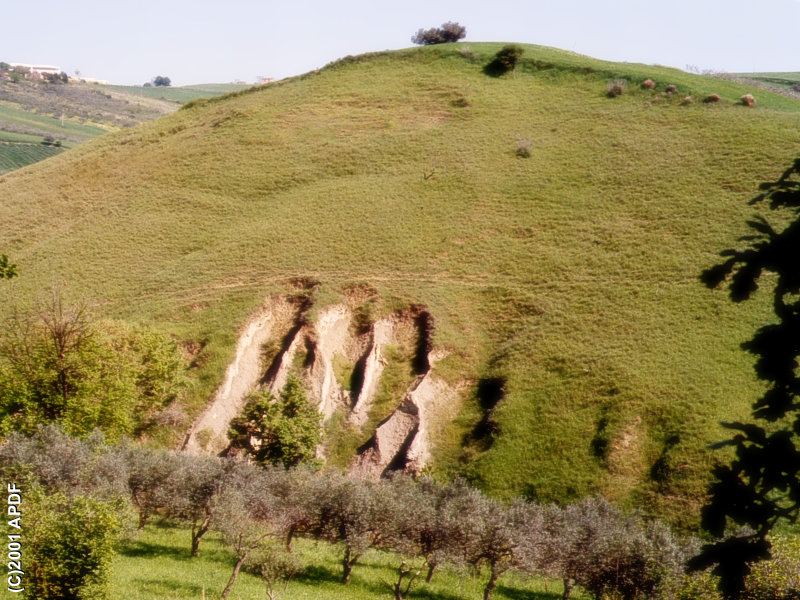
Cupello | 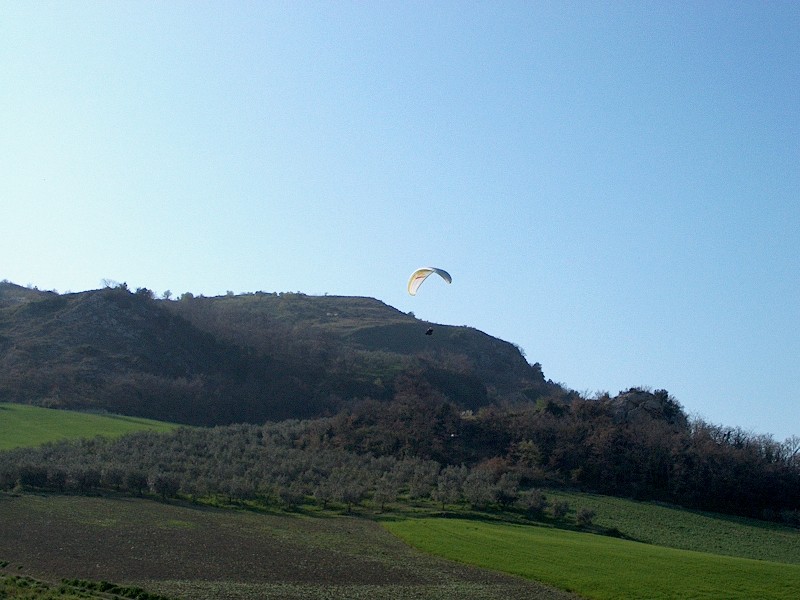
Lentella |
A place built above a large stone, which seemed to be inaccessible from three directions. The site is elusive, the air is excellent and the view too. From the northern part and towards the Adriatic runs a small river called the Tresta, where after two miles or so, it joins the river Trigno, it is named after the Spanish, “lindo” which is good and clean to say. | If not we can accompany you on a journey towards Punta Penna, the description we will leave entirely in the words of the monk: | 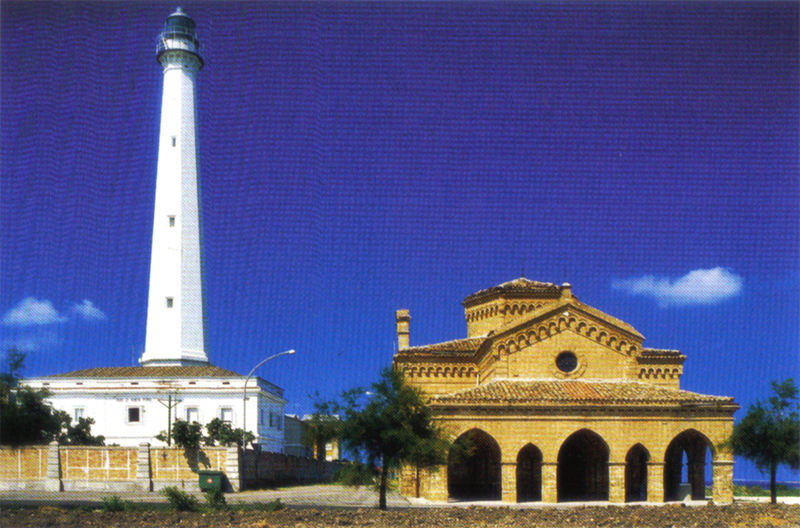
Punta della Penna | So the Tower of Penna del Vasto is an elevated site on the cliffs of the sea, with a sheer drop into the sea, a beautiful view, fresh air, this place given by God reigns over the Adriatic gulf. Today the tower still exists and it is the headquarters of a sophisticated military radar system, but the view over the bay is still just as good. | From the beach of Punta Penna we can immerge in the adjacent Sea Reserve of Punta Aderci, one of the most fascinating and interesting places on the Adriatic coast, an unspoilt area, full of botanic species found in a marine habitat. | 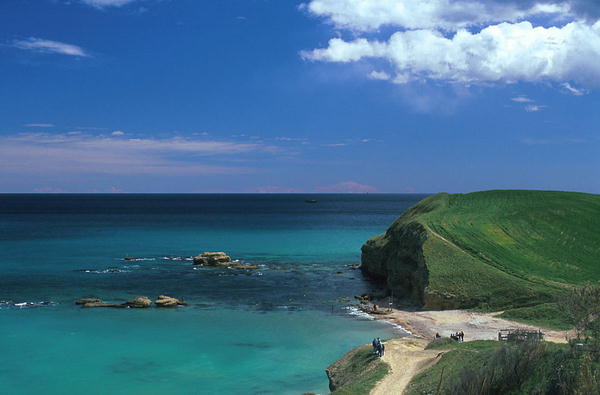
Beach of Punta d'Erce |
The rocky cliffs, jutting out into a limpid sea, the grottos, the remains of the old fishermen’s tools, all go together to make a small corner in paradise, and from here, running alongside the long, narrow pebbly beach of Mottagrossa we can slowly take the road that heads northwards, leaving behind unforgettable memories. |
|
|
|
|